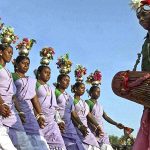Chhattisgarh
Nestled along the border with Orissa, Chhattisgarh is a small yet culturally rich state.
Chhattisgarh, a state in central India, is a treasure trove of tribal diversity, housing various tribal castes that contribute to its unique cultural landscape. Among the many tribes, the Gonds of Bastar stand out as the most prominent, but the state is also home to a myriad of other tribes, each with their own distinct traditions and way of life. The Gonds of Bastar are perhaps the most well-known tribe in Chhattisgarh, particularly in the Bastar region. Their presence in the state is significant, reflecting their deep connection to the land. The Gonds are one of the largest tribal groups in India, known for their rich cultural heritage and traditional practices.
The Baiga Tribe, also referred to as the Panda, is another key ethnic group in Chhattisgarh. Although their primary population is located in Madhya Pradesh, there are smaller numbers in Uttar Pradesh, Chhattisgarh, and Jharkhand. The Baiga people traditionally inhabit the mountainous and forested regions of eastern India. Within the Baiga tribe, several sub-castes exist, including Bijhwar, Narotia, Bharotiya, Nahar, Rai Bhaina, and Kadh Bhaina. The Baigas are known for their distinctive way of life and are considered one of the ancient tribes with deep-rooted traditions. Historically, they have been involved in agriculture, hunting, and gathering.
The Birhor Tribe is another significant group in Chhattisgarh, as well as Jharkhand. They are primarily nomadic, speaking the Birhor language, which belongs to the Munda family of Austroasiatic languages. The name “Birhor” combines two Mundari words: bir (jungle) and hor (man), translating to “men of the jungle.” The Birhors are known for their skills in rope-making from native trees and creeper fibers, known as chop. They often reside near peasant communities to sell handmade ropes and forest products at local markets called ‘Hatt.’ Their lifestyle is primarily centered on hunting and gathering, and they hold supernatural beliefs related to certain plants and animals. The Pahari Korwa Tribe is one of the most vulnerable and threatened tribal groups in India. This hill tribe faces numerous challenges, including malnutrition and inadequate care for their young and elderly. The Pahari Korwas live in the hilly regions of Chhattisgarh and are known for their unique cultural practices and traditional lifestyle. The Baiga Priests, there are individuals who serve as village priests or sorcerers.
These priests, also referred to as Baigas, are considered knowledgeable about the mysteries of the region’s soil and natural world. The Baigas have traditionally been closely associated with the forests and their deep understanding of plants and animals reflects their intimate relationship with their environment.
Other Notable Tribes
Chhattisgarh’s tribal tapestry includes several other significant groups such as the Abhuj Maria, BisonHorn Maria, Muria, Halbaa, Bhatra, and Dhurvaa. Each of these tribes adds to the rich cultural mosaic of the state, with their own unique customs, traditions, and ways of life.
Chhattisgarh’s tribal communities embody a remarkable spectrum of cultural diversity and tradition. From the prominent Gonds of Bastar to the nomadic Birhor and the vulnerable Pahari Korwas, each tribe contributes to the state’s vibrant cultural heritage. The Baigas, in particular, stand out as a peaceful and welcoming indigenous group, showcasing the rich traditions and deep connections to the land that define Chhattisgarh’s tribal identity. The diversity of these tribes not only enriches the cultural fabric of Chhattisgarh but also highlights the broader spectrum of India’s indigenous heritage.
Social Share

At Primitive Tales, we delve deeply into the essence of primitive life… much before urbanization came in. Our focus extends to the history of the tribes, their art, architecture, religion, and an overview on their life, one will enhance and gather fresh and new insights and experiences, enhancing our understanding of diverse cultures and enriching human understandings.




